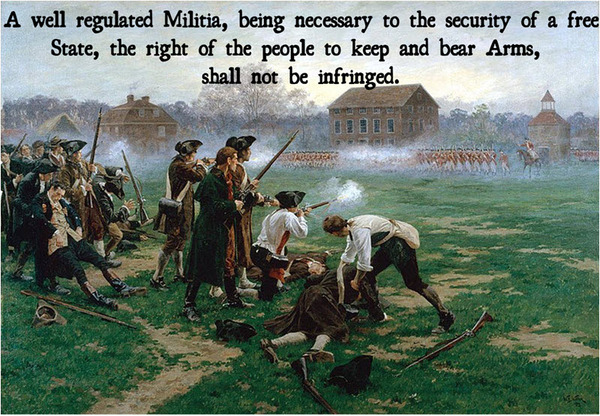
–>
July 7, 2022
With Bruen, SCOTUS made it clear that citizens in all fifty states must be permitted to carry guns. But in its zeal to make narrow rulings, the Court just made more work for itself. The Court overruled New York’s “may issue” carry permit regime, to which the state simply said, “Up yours!” and passed a new law that basically made the entire state a “sensitive area” in which guns cannot be carried.
‘); googletag.cmd.push(function () { googletag.display(‘div-gpt-ad-1609268089992-0’); }); }
This problem arises from an institutional tendency of the Supreme Court. When it accepts a case, the Court will list the “Question(s) Presented.” These are typically very brief summaries of the issues that the Court will review. In Bruen, it was “Whether the State’s [New York’s] denial of petitioners’ applications for concealed-carry licenses for self-defense violated the Second Amendment.” And the ultimate decision dealt with that limited question.
It’s generally impossible for the Supreme Court to narrowly rule without discussing some closely related issues. For example, in Bruen, the issue of sensitive places arose. Those are a few (very limited) places where concealed carry would present a serious problem. As the founders understood it, this was primarily governmental facilities such as Courts. The “sensitive place” concept did not extend to wide areas, although no one objected to the idea that an individual might ban guns from his own establishment. Beyond that, guns were basically everywhere. They were tools of public peace.
Justice Thomas wrote that if a state wanted to be more restrictive, “The government must then justify its regulation by demonstrating that it is consistent with the Nation’s historical tradition of firearm regulation. Only then may a court conclude that the individual’s conduct falls outside the Second Amendment’s ‘unqualified command.’” New York’s law clearly falls outside that historical tradition.
‘); googletag.cmd.push(function () { googletag.display(‘div-gpt-ad-1609270365559-0’); }); }
But that’s not the only work the Court left for itself. Lower Courts have twisted themselves into an ouroboros to avoid the plain language of Heller and MacDonald. With Bruen adding to the library of Second Amendment decisions, SCOTUS sent several cases back to lower courts for reconsideration.
Young v. Hawaii is very similar to Bruen and will almost certainly lead to eliminating most of Hawaii’s restrictions, including the “good moral character” rule that New York has adopted to sidestep Bruen’s prohibition on “good cause” requirements for carry licenses.

Image by Andrea Widburg, made using a public domain painting.
In Duncan v. Bonta, the 9th Circuit ruled en banc that California’s ban on magazines holding more than ten rounds was constitutional. It did this with a two-step “balancing test” that SCOTUS declared impermissible. As Justice Thomas noted, such “interest balancing” tests violate the basic premise that “when the Second Amendment‘s plain text covers an individual’s conduct, the Constitution presumptively protects that conduct.”
Further, it’s clear that large-capacity magazines are part of weapons that are in “common use,” a protected status under Heller. Historically, they even existed before the American Revolution, making them a part of our traditions. It’s almost certain that Duncan v Bonta will be reversed on rehearing. The same conclusion seems certain in Association of New Jersey Rifle and Pistol Clubs v. Bruck because the issue is essentially the same.
A related case that is also likely to be overturned on rehearing is Bianchi v. Frosch, a case that upheld Maryland’s ban on “assault weapons.” In this case, the 4th Circuit court ruled that such guns were similar to “weapons that are most useful in military service” and “thus outside the ambit of the Second Amendment.”
This is indeed curious because the first major SCOTUS case on the subject, US v. Miller (1939), ruled that a sawed-off shotgun was not a military-style weapon suitable for an organized militia, and therefore not protected. Thus, SCOTUS explicitly protected military-style weapons but the 4th Circuit held that military-style weapons were not protected.
‘); googletag.cmd.push(function () { googletag.display(‘div-gpt-ad-1609268078422-0’); }); } if (publir_show_ads) { document.write(“
Most of the gun features in Bianchi are appearance-related and have little effect on the gun’s function. In particular, the Maryland law outlaws all variants of the AK-47 and AR-15 as “assault rifles.” Because these are the two most popular rifles in America, they are protected under Heller, along with the other forty-three listed guns and “their copies, regardless of which company produced and manufactured that assault weapon.” A ten-round magazine limit is in the law for good measure.
All four of these decisions should be reversed on rehearing. But that leaves New York’s incredibly mangled legal reading of the term “sensitive spaces” and definitive legal discussions of a number of firearms features for SCOTUS to elucidate.
Just as the Court used Dobbs as a vehicle to overturn Roe, it’s past time for the Court to lay down the law about firearms. The Second Amendment means what it says. What a gun looks like is unimportant. Its size is also unimportant.
My AR-15 pistol is an inch longer than the Israeli Tavor battle rifle. The Tavor has a fully automatic mode, while my AR does not. The Tavor has a 16-inch barrel, while my pistol has a ten-inch barrel and sends the same bullet downrange about 600 feet per second slower than the Tavor.
In short, there’s no legally meaningful distinction between rifle and pistol. Yet if I put a $25 piece of plastic (vertical pistol grip) on the front of my pistol, it becomes an illegal “short-barreled rifle,” while the smaller Tavor can have the same item and stay legal.
If the Left wants to ban guns, there’s a way to do it, and it’s in black and white: Amend the Constitution. But they can’t be bothered. They are righteous, and we are evil, so they must impose their way. We peons must submit.
SCOTUS must affirmatively invalidate large capacity magazine and “assault rifle” bans. Those have nothing to contribute to public safety and stand firmly crosswise of the Constitution. While we are at it, we should reconsider the National Firearms Act of 1934. The advance of technology has rendered it irrelevant. But that’s a subject for another post.
Ted Noel MD is a retired Anesthesiologist/Intensivist who podcasts and posts on social media as DoctorTed and @vidzette. His DoctorTed podcasts are available on many podcast channels.
<!– if(page_width_onload <= 479) { document.write("
“); googletag.cmd.push(function() { googletag.display(‘div-gpt-ad-1345489840937-4’); }); } –> If you experience technical problems, please write to [email protected]
FOLLOW US ON
<!–
–>
<!– _qoptions={ qacct:”p-9bKF-NgTuSFM6″ }; ![]() –> <!—-> <!– var addthis_share = { email_template: “new_template” } –>
–> <!—-> <!– var addthis_share = { email_template: “new_template” } –>





